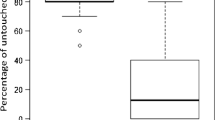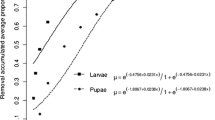Abstract
Varroa jacobsoni, an ectoparasite of the Asian honeybee Apis cerana, has been introduced world-wide, and is currently decimating colonies of the European honeybee Apis mellifera. Varroa's reproductive cycle is tuned to that of drone cells, those mainly parasitized in the original host. We describe here how a single fertilized female, infesting a brood cell, can produce two to four adult fertilized females within the limited time span of bee development (270 h in worker and 320 h in drone cells), despite the disturbance caused by cocoon spinning and subsequent morphological changes of the bee. From observations on transparent artificial cells we were able to show how the mite combats these problems with specialized behaviors that avoid destruction by the developing bee, prepares a feeding site for the nymphs on the bee pupa, and constructs a fecal accumulation on the cell wall which serves as a rendezvous site for matings between its offspring. The proximity of the fecal accumulation to the feeding site facilitates feeding by the maturing progeny. However, communal use of the feeding site leads to competition between individuals, and protonymphs are most disadvantaged. This competition is somewhat compensated by the timing of oviposition by the mites. Use of a common rendezvous and feeding site by two or more Varroa mothers in multiinfested cells may have developed from the parental care afforded to them as nymphs.
Similar content being viewed by others
References
Akimov IA, Yastrebtsov AV, Gorgol VT (1988) Functional and morphological specialization of Varroa jacobsoni for parasitism. In: Needham GR, Page RE Jr, Delfinado-Baker M, Bowman CE (eds) Africanized honey bees and bee mites. Ellis Horwood, Maidenhead, pp 475–478
Akimov IA, Pileckaja IP, Jastrebcov AV (1990) Reproductive cycle of Varroa jacobsoni and its host connections (translated from Russian). Vestnik Zool :41–46
Baker RA (1991) Development and life-history strategies in mussel mites (Hydrachnellae: Unionicolidae). In: Schuster R, Murphy PW (eds) The Acari. Reproduction, development and life-history strategies. Chapman and Hall, New York, pp 65–73
Beetsma J, Zonneveld K (1992) Observations on the initiation and stimulation of oviposition of the Varroa mite. Exp Appl Acarol 16:303–312
Bell JW (1985) Sources of information controlling motor patterns in arthropod local search orientation. J Insect Physiol 31:837–847
Biasiolo A (1992) Lack of allozyme variability among Varroa mite populations. Exp Appl Acarol 16:287–294
Boecking O, Drescher W (1991) Response of Apis mellifera L. colonies infested with Varroa jacobsoni Oud. Apidologie 22:237–241
Boecking O, Drescher W (1992) The removal response of Apis mellifera L. colonies to brood in wax and plastic cells after artificial and natural infestation with Varroa jacobsoni Oud. and to freeze-killed brood. Exp Appl Acarol 16:321–329
Boot WJ, Calis JNM, Beetsma J (1992) Differential periods of Varroa mite invasion into worker and drone cells of honey bees. Exp Appl Acarol 16:295–301
Brandmayr P (1992) Short review of the presocial evolution in Coleoptera. Ethol Ecol Evol Special Issue 2:7–16
Büchler R, Drescher W, Tornier I (1992) Grooming behaviour of Apis cerana, Apis mellifera and Apis dorsata and its effect on the parasitic mites Varroa jacobsoni and Tropilaelaps clareae. Exp Appl Acarol 16:313–319
Buskirk RE (1981) Sociality in the Arachnida. In: Herrmann HR (ed) social insects, vol II. Academic Press, New York London Toronto Sydney San Francisco, pp 281–367
De Jong D, De Jong PH, Gonçalves LS (1982) Weight loss and other damage to developing worker honeybees from infestation with Varroa jacobsoni. J Apicult Res 21:165–167
Delfinado-Baker M, Rath W, Boecking O (1992) Phoretic bee mites and honeybee grooming behavior. Int J Acarol 18:315–322
Dong Huiqin, Chant AD (1986) The olfactory response of three species of predacious phytoseiid mites (Acarina: Gamasina) to a prey tetranychid species. Intern J Acarol 12:51–55
Eickwort GC (1981) Presocial insects. In: Hermann HR (ed) Social insects, vol II. Academic Press, New York London Toronto Sydney San Francisco, pp 199–280
Erickson EH, Lusby DA, Hoffman GD, Lusby EW (1990) On the size of cells speculations on foundation as a colony management tool. Gleanings Bee Cult 118:98–101
Fuchs S (1990) Bevorzugung von Drohnenbrutzellen in Bienenvölkern von Apis mellifera carnica durch Varroa jacobsoni. Apidologie 21:193–200
Fuchs S, Langenbach K (1989) Multiple infestation of Apis mellifera L. brood cells and reproduction in Varroa jacobsoni Oud. Apidologie 20:257–266
Glinski Z, Jarosz J (1992) Varroa jacobsoni as a carrier of bacterial infections to a recipient bee host. Apidologie 23:25–31
Griffiths DA (1988) Functional morphology of the mouthparts of Varroa jacobsoni and Tropilaelaps clareae as a basis for the interpretation of their life-styles. In: Needham GR, Page RE Jr, Delfinado-Baker M, Bowman CE (eds) Africanized honey bees and bee mites. Ellis Horwood, Maidenhead, pp 479–486
Hamilton WD (1964) The genetical evolution of social behaviour I and II. J Theor Biol 7:1–52
Hänel H, Ruttner F (1985) The origin of the pore in the drone cell capping of Apis cerana Fabr. Apidologie 16:157–164
Hérard F, Keller MA, Lewis WJ, Tumlinson JH (1988) Beneficial arthropod behavior mediated by airborne semiochemicals. IV. Influence of host diet on host-oriented flight chamber responses of Microplitis demolitor Wilkinson. J Chem Ecol 14:1597–1606
Hislop RG, Prokopy RJ (1981) Mite predator responses to prey and predator-emitted stimuli. J Chem Ecol 7:895–904
Ifantidis MD (1983) Ontogenesis of the mite Varroa jacobsoni in worker and drone honeybee brood cells. J Apicult Res 23:200–206
Ifantidis MD (1988) Some aspects of the process of Varroa jacobsoni mite entrance into honeybee Apis mellifera brood cells. Apidologie 19:387–396
Ifantidis MD (1990) Reexamination of reproduction parameters of the mite Varroa jacobsoni Oudemans. In: Ritter W, Laere van O, Jacobs F, Wael de L (eds) Proc intern symposium on recent research on Bee pathology, Gent 1990. Janssen Pharmaceutica, Boerse, Belgium, pp.20–26.
Ifantidis MD, Rosenkranz P (1988) Reproduktion der Bienenmilbe Varroa jacobsoni (Acarina: Varroidae). Entomol Gener 14:111–122
Koch W, Ritter W (1991) Experimental examinations concerning the problem of deformed emerging bees after infestation with Varroa jacobsoni. J Vet Med B 38:337–344
Le Conte Y, Arnold G, Trouiller J, Masson C, Chappe B, Ourisson G (1989) Attraction of the parasitic mite Varroa to the drone larvae of honey-bees by simple aliphatic esters. Science 245:638–639
Lewis WJ, Tumlinson JH (1988) Host detection by chemically mediated associative learning in a parsitic wasp. Nature 331:257–259
Lin N, Michener CD (1972) Evolution of sociality in insects. Q Rev Biol 47:131–159
Michener CD (1974) The social behavior of the bees. Harvard University Press, Cambridge
Moosbeckhofer R, Fabsicz M, Kohlich A (1988) Untersuchungen über die Abhängigkeit der Nachkommensrate von Varroa jacobsoni (Oudemans) vom Befallsgrad der Bienenvölker, Apidologie l9:181–207
Otten C (1991) Vergleichende Untersuchungen zum Populationswachtum von Varroa jacobsoni Oud. in Völkern von Apis mellifera L. unterschiedlicher geographischer Herkunft. PhD Thesis, Univ. Frankfurt am Main
Peng Y-S, Fang Y, Xu Sh, Ge L (1987a) The resistance mecanism of the Asian honeybee Apis cerana Fabr. to an ectoparasitic mite Varroa jacobsoni Oudemans. J Invert Pathol 49:54–60
Peng Y-S, Fang Y, Xu Sh, Ge L, Medhat, Nasr E (1987b) Response of foster Asian honeybee Apis cerana colonies to the brood of European honeybee Apis mellifera infested with parasitic mite Varroa jacobsoni. J Invert Pathol 49:259–264
Potter DA, Wrensch DL, Johnston DE (1976) Aggression and mating success in male spider mites. Science 193:160–161
Radovsky FJ (1985) Evolution of mammalian mesostigmate mites. In: Ke Chung Kim (ed) Coevolution of parasitic arthropods and mammals. Wiley & Sons, New York Chichester Brisbane Toronto Singapore, pp 441–504
Rath W (1992) Der Schlüssel für Varroa: Die Apis cerana-Drohnen und ihr Zelldeckel. Allg Dtsch Imkerz 26:12–14
Rath W, Drescher W (1990) Response of Apis cerana Fabr. towards brood infested with Varroa jacobsoni (Oudemans) and infestation rate of colonies in Thailand. Apidologie 21:311–321
Rehm SM, Ritter W (1989) Sequence of the sexes in the offspring of Varroa jacobsoni and the resulting consequences for the calculation of the developmental period. Apidologie 20:339–343
Rickli M, Guerin PM, Diehl PA (1992) Palmitic acid released from honeybee worker larvae attracts the parasitic mite Varroa jacobsoni on a servosphere. Naturwissenschaften 79:320–322
Rosenkranz P (1990) Wirtsfaktoren in der Steuerung der Reproduktion der parasitischen Bienenmilbe Varroa jacobsoni in Völker von Apis mellifera. PhD Thesis, Univ. Tübingen
Rovner JS (1991) Turning behavior during pheromone-stimulated courtship in wolf spiders. Anim Behav 42:1015–1016
Royalty RN, Phelan PL, Hall FR (1993) Quantitative and temporal analysis of effects of twospotted spider mite Acari: Tetranychidae female sex pheromone on male guarding behavior. J Chem Ecol 19:211–223
Saitò Y (1983) The concept of “life types” in Tetranychinae. An attempt to classify the spinning behaviour of Tetranychinae. Acarologia 24:377–391
Saitò Y (1986a) Biparental defence in a spider mite (Acari: Tetranychidae) infesting Sasa bamboo. Behav Ecol Sociobiol 18:377–386
Saitò Y (1986b) Prey kills predator: counter-attrack success of a spider mite against its specific phytoseiid predator. Exp Appl Acarol 2:47–62
Sakofski F, Koeniger N, Fuchs S (1990) Seasonality of honey bee colony invasion by Varroa jacobsoni Oud. Apidologie 21:547–550
Schneider P, Drescher W (1988) Die Folgen eines unterschiedlich hohen Varroa-Befalls während der Puppenentwicklung auf die erwachsene Biene. Allg Dtsch Imkerz 22:16–18/54–56/87–91
Schulz AE (1984) Reproduktion und Populationsentwicklung der parasitischen Milbe Varroa jacobsoni Oudemans in Abhängigkeit vom Brutzyklus ihres Wirtes Apis mellifera L. Apidologie 15:401–420
Steiner J (1992) Reproduktion der ektoparasitischen Bienenmilbe Varroa jacobsoni in Völkern von Apis mellifera carnica. Ph.D. Thesis, Univ. Tübingen
Steiner J (1993) Vom Ei zur Milbe: Varroa jacobsoni. Dtsch Bienen J 1:296–300
Tewarson NC, Singh A, Engels W (1992) Reproduction of Varroa jacobsoni in colonies of Apis cerana indica under natural and experimental conditions. Apidologie 23:161–171
Treat AE (1958) Social organization in the moth ear mite Dichrocheles (Myrmonyssus) phalænodectes. Proc. 10th Intern. Congress Entomol., Montreal, 1956. Vol. 2, pp 475–480
Treat AE (1975) Mites of moths and butterflies. Cornell University Press, Ithaca London
Tumlinson JH, Turlings TCJ, Lewis WJ (1993) Semiochemically mediated foraging behavior in beneficial parasitic insects. Insect Biochem Physiol 22:385–391
Vet LEM, Groenewold AW (1990) Semiochemicals and learning in parasitoids. J Chem Ecol 16:3119–3135
Wheeler WM (1926) Les sociétés d'insectes — leur origine — leur évolution. Gaston Doin, Paris
Wilkinson L (1990) Sygraph: The system for graphics. Systat Inc, Evanston
Wilson EO (1975) Sociobiology. Belknap Press, Cambridge
Author information
Authors and Affiliations
Rights and permissions
About this article
Cite this article
Donzé, G., Guerin, P.M. Behavioral attributes and parental care of Varroa mites parasitizing honeybee brood. Behav Ecol Sociobiol 34, 305–319 (1994). https://doi.org/10.1007/BF00197001
Received:
Accepted:
Issue Date:
DOI: https://doi.org/10.1007/BF00197001




